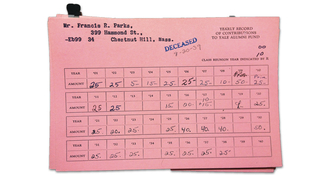 loading
loading
Old YaleThe invention of the Alumni FundThe oldest annual giving program in America was launched in 1890. Judith Ann Schiff is chief research archivist at the Yale University Library.  Manuscripts and ArchivesLong before computers arrived at Yale, donations to the Yale Alumni Fund were meticulously tracked on donation cards like these. View full imageIn 1886, when Timothy Dwight, Class of 1849, became president of Yale, the university was in trouble. The problem was money. Since 1701, when the colonial assembly of Connecticut voted “£120 in country pay to be paid annually” and Major James Fitch donated a farm of 637 acres, Yale had relied on a mix of public and private funding. For many decades, it worked. By the mid-nineteenth century Yale was America’s leading educational institution. But Dwight found Yale in so much financial difficulty when he took office that he doubled as treasurer of the university and donated his salary. He pointed out repeatedly in his reports that generous gifts of grand buildings in turn necessitated gifts of unrestricted funds, to underwrite the teaching and learning within those buildings. With Yale in extremity, a group of Yale alumni came together to help. On March 24, 1890, 125 years ago, members of the alumni association that would become the Yale Club of New York City met informally. This meeting saw the start of the Yale Alumni Fund, the oldest annual giving program in America. The prime movers of the plan were Edward G. Mason ’60 and Thomas Thacher ’71. Mason would chair the first board of the Alumni University Fund Association; he was a prominent Chicago lawyer and an alumni fellow of the Yale Corporation (Yale’s board of trustees). Thacher, who would become vice chair, was a New York lawyer and a lecturer at the Yale Law School. According to a 1917 Yale Alumni Weekly article, Thacher told the group that “there were numbers of men who could afford to give but little, who appreciated keenly what Yale had done for them.” He proposed establishing a fund to which, for the first time, alumni “of moderate means could make small contributions on a regular basis.” It was agreed that the directors would not invest the funds and that use of the funds would be “absolutely in the discretion of the Corporation.” In the first year, the directors projected that half of the 7,000 living alumni would contribute $10 to $1,000 each, for a total of $104,000. They fell abysmally short. Just 385 alumni donated, producing only $10,615. By 1893, the directors had developed the “class agent” system, by which a member of every graduating class solicits donations from classmates. Gradually, this approach began to succeed. In 1898 the fund finally raised over $11,000. It grew quickly thereafter, to a quarter of a million dollars in 1917. One of the most successful class agents was William M. Barnum, Class of 1877, who served from 1893 until his death in 1926. He is credited with starting the tradition of a special class gift during a reunion year. During 1926–27, the fund raised almost $572,000—$106,000 of which was given by 49 of his surviving 51 classmates. Overall contributions tumbled during the Depression but began to build after World War II. The 1950s and ’60s saw major milestones: $1 million during 1950–51, $2 million during 1958–59, $3 million during 1962–63. Since 1890, the fund has received more than $1 billion and has become one of the most successful annual giving programs in America. During 2013–14, it provided—with the aid of some 2,000 alumni volunteers—more than $35 million to support Yale’s current activities. Over 125 years, a dozen Yale presidents have commented on the role and contributions of the Alumni Fund. In 1965, the fund’s 75th anniversary, President Kingman Brewster Jr. ’41 declared: “For the nation the fund is a yardstick—measured in envy by our strongest rivals—measured in aspiration and appreciation of all those who care about educational quality, independence, and integrity.”
The comment period has expired.
|
|